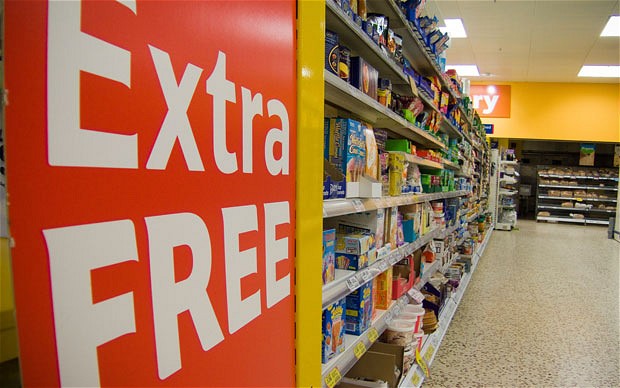By www.shape.com | Tuesday, 17 June 2014

You walk in needing yogurt, but you walk out with half a dozen snacks and sale items, a bottled tea, and a wallet that’s $100 lighter. (On top of that, you probably forgot all about that yogurt.)
It’s not magic. Today’s supermarkets are engineered to coax your brain toward buying impulsively. Here’s how:
When you first walk in
Flowers, fruits, and vegetables are almost always located near the store’s entrance. Why? These products give your brain the impression you’re entering someplace natural and fresh—a pleasant oasis apart from the rest of your workaday, explains Melanie Greenberg, Ph.D., a Northern California-based psychologist.
Produce stacked on crates or tumbled into baskets send your brain a subconscious message: These fruits and veggies were brought in straight from the field, as opposed to being shipped via industrial containers, Greenberg says.
You’re also likely to see (and smell!) the bakery, says Aner Tal, Ph.D., of the Cornell University Food & Brand Lab. Store owners know the scents of fresh-baked goods trigger hunger pangs. And when you’re hungry, you’re more likely to grab delicious-looking foods you didn’t intend to purchase, research shows.
In the event you change your mind and decide to leave the store, automatic doors triggered by sensors on the outside only block your path. Along with other barriers, these impediments force you to walk through a big section of the store on your way out, Greenberg explains.
In the aisles
Researchers know you tend to scan the middle sections of shelves and the ends of grocery aisles most. For that reason, grocery stores place the most enticing items in those locations, Tal says. On the other hand, bargain brands and specialty items are usually tucked into the top and bottom shelf spaces your eyes ignore.
For similar reasons, the stuff you want most (milk, eggs, and butter) is nearly always placed as far away from the store entrance as possible, Tal explains. This forces you to pass a lot of other products on the way. And the more stuff you pass, the more likely you are to toss things into your cart, studies show. (Grocery carts themselves have grown bigger over time, which studies show encourages you to buy more in order to fill them.)
Sales and specials
When you see a price reduction or sale item (those yellow tags that shout 'Two for one!' or 'Save 30 Percent!'), a part of your brain called the mesial prefrontal cortex lights up, finds a study from Stanford University. The belief that you may save money also switches off the part of your noodle linked to pain and decisions not to buy, the study suggests. Even if you don’t really need the sale item, your brain nudges you toward purchasing it, the study indicates.
Supermarkets also use a technique called 'anchoring,' first laid out by Israeli researchers in the 1970s. Anchoring involves tying your mind to an initial, higher price so that whatever price is being offered looks like a sweet deal. An example: If you see an item being sold on its own for $3.99, you’re a lot less likely to buy it than if, right above this price, you also see, 'Regularly $5.49.' Your brain believes you’re saving money even though you probably wouldn’t have bought the item without the price comparison.
Scanning product labels
It’s no surprise that food marketers highlight their product’s healthiest aspects with claims like '0 Trans Fats!' or '100 Percent Whole Grain!' And while these statements are (usually) true, that doesn’t mean the foods inside aren’t packed with other junky additives, Tal says. There’s also research that shows green food labels make products seem healthy to you, even if the items are cookies or ice cream.
Some labels also accentuate a product’s basic feature to make it seem unique, Tal says. An example: One yogurt container may say, 'Great Source of Probiotics!' even though all yogurt is naturally probiotic. And expiration or 'best by' dates now appear on everything from pasta sauce to toilet-bowl cleaners. But don’t be fooled into believing these products expire so rapidly, Greenberg warns. 'Product marketers add expiration dates to encourage you to buy fresher items,' she explains. In most cases, even milk and eggs will last several days past the labeled date, she adds.
While you check out
After the marketing onslaught you’ve just pushed your cart through, the checkout lane may be the biggest test of willpower. Multiple experiments have found your self-control tends to break down when you’re forced to make lots of decisions. Consumer experts have found your worn-out brain is more likely to be enticed by candy, magazines, and other impulse-buys at the register.
comments
Reddit co-founder Alexis Ohanian engaged to tennis superstar Serena Williams
Charles Aznavour receives honorary Hollywood star plaque
Galstaun College alumni twins dominate emoji sales
Trailer for film based on William Saroyan’s ‘The Human Comedy’ released
First eco-tourism festival to be held in June in Armenia
Winston Churchill and His Love for ‘Ararat’ Brandy
Armenian among 60 most influential languages worldwide, according to MIT research
Conan O’Brien to shoot episode in Armenia